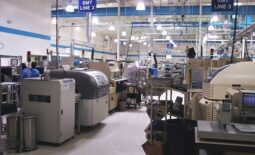The advantages of industry 4.0 for the Mexican maquiladoras
Automation and industry 4.0 technologies are becoming increasingly commonplace in the Mexican maquiladoras. Proof of this fact is that companies that provide goods and services that are related to automation and industry 4.0 have become loyal suppliers to Mexico’s export industry.
Simplifying automation
For Festo’s Sandro Quintero, automation today consists of four fundamental pillars. They are flexibility, adaptability, interoperability, and simplification.
What he observes in the Mexican maquiladoras is that machine manufacturers and end-users are asking for more specific requirements, smarter machines and are running different products simultaneously.
“Before, machines were rigid and had a limited scope of use. It took time to make a new product and it required the intervention of technicians to adjust and install needed machines,” he said.
However, he stressed that even though today machines have become more complex, users want them to be simple to operate.
As an example, he gave the use of manuals in today’s smartphones. “We all have smartphones, but nobody uses manuals anymore. The devices are intuitive. That’s what the workers in the Mexican maquiladoras and the consumer are asking for,” he said.
On Industry 4.0, he said that many manufacturers have some familiarity with the issue, but do not know how to implement it and are unaware of its advantages.
“It is important to know that industry 4.0 serves to both acquire data from the lower part (sensor) and the upper part (server), and also serves by demonstrating how to improve processes or adapt them,” he explained.
A fundamental aspect that Quintero pointed out is that for automation to be exploited effectively by the Mexican maquiladoras there must be an interaction between the manufacturer of the equipment, the machinery (integrators), and the end-users (production facilities).
“It is very important because if there is a disconnect between suppliers and users, companies will not be able to take advantage of the full potential of a machine. If the user doesn’t put the data that is being generated to practical use, then the concept of industry 4.0 doesn’t work,” he said.
The following is the cycle for tools and services that should be followed in an automated and industry 4.0 environment:
- Make sure the system is up to date.
- Optimize the energy consumption of existing systems.
- Identify any defects as soon as possible and replace defective components quickly.
- Find the desired product instantly.
- Reduce sources of expenses using tools and programs.
Sensotek: the challenges of industry 4.0
For her part, Jacqueline Jáquez, sales executive of Sensotek, said that industry 4.0 is composed of the internet of things, the digitization of information, processes, and operations managed through technological tools that allow time savings and the elimination of errors.
For Jáquez, digital data by all the collaborators that make up an industry, in addition to machines, are important, since it generates more productivity, competitiveness, and efficiency.
One challenge is to achieve a common language that serves as a basis for the use of production systems in the Mexican maquiladoras. For this reason, digital information is important:
- Big data – Information on the Internet that must be organized so that it is used, analyzed through computer systems, and used in a way that enhances the operations of an organization.
- SAP – Internal information management system that allows for better organization of the departments.
- Information and Communication Technologies – These allow companies to remain current in their markets
- Computer servers -They enable manufacturers to store valuable information that, in addition, require maintenance systems for its optimal use.
Jáquez also addressed the issue of the viability of automation. For her, automating a process in the Mexican maquiladoras does not generate job loss.
According to a recent report on trends in manufacturing, 45% of the industry’s activities can be done with robots. Maintaining factory workers on the job is a question of creating new and better-paid positions in companies.
She maintains that robotics can work with human talent in the Mexican maquiladoras without the loss of work. An example is the digital twin, from Siemens, which is the creation of a virtual copy of a machine. A digital twin is always run by a human being.
“You can’t replace the human element in manufacturing because there will always be tasks machines are not capable of performing,” she added.
One development in the use of technology in manufacturing is that the price of industrial robots is trending downward these days. Jáquez also stressed that industry 4.0 must also be considered to be the new normal should a company wish to maintain its competitive position.




